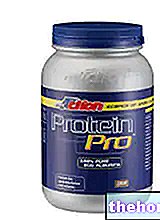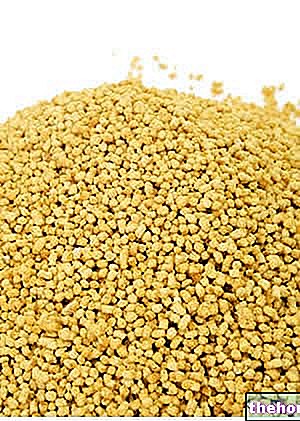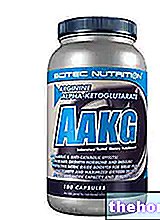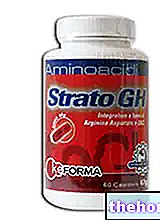See also: synephrine in bitter orange - Essential oil of bitter orange - Bitter orange as an example of plant drug - Bitter Orange in Herbalist
What is Bitter Orange
If the sweet orange represents a food of high nutritional interest, the bitter orange, although less appreciable in flavor, is a typical ingredient of many cosmetic and phytotherapeutic products. For this purpose the peel of the fruits, the leaves and the flowers collected before their opening are used.
Originally from India, this tree (Citrus aurantium) grows in subtropical climate regions, including Spain and Southern Italy.

Properties and Uses
The infusion of flowers or leaves (5 grams of flowers in 250 ml of boiling water for ten minutes), is recommended for those suffering from insomnia; the one prepared with the peel, on the other hand, facilitates digestion, stimulating chlorine-peptic secretion, both for the taste perceived by the taste buds of the tongue, which due to the contact of essential oils on the gastric mucosa.
Also from the peel, the essential oil of bitter orange is obtained, with anti-inflammatory and disinfectant properties.

Too bitter to be eaten fresh, the pulp of this citrus fruit is a typical ingredient in jams and is also used in cosmetics (according to popular tradition, it can be applied to the face as an anti-wrinkle product).
To lose weight
Bitter orange is also a typical ingredient of many thermogenic or fat-burning supplements. Some American researchers have in fact discovered that in precise stages of ripeness, the unripe and dried fruit is enriched with a mixture of sympathomimetic amines, of which synephrine it represents its main constituent. This substance has anorectic properties, in the sense that it is capable of causing a significant reduction in food intake. The slimming properties of synephrine also derive from its stimulatory effect on thermogenesis (production of body heat = increase in calorie consumption) and on lipolysis (use of fats for energy purposes).
For all these reasons, bitter orange is a typical ingredient of slimming and anti-cellulite products, where it is usually found in association with caffeine and other drugs or plant extracts with similar activity (Guarana, Cola, Erba mate, Ephedra sinica, Garcinia cambogia , yohimbine) or diuretic, "anti-cellulite" and protective on the microcirculation (Blueberry, Birch, Centella asiatica, Pineapple stem).
Side effects
The use of bitter orange-based supplements can be dangerous in subjects at cardiovascular risk (hypertherthesis, cardiopathic, obese, hyperthyroid), in children under the age of 12, in pregnant and breastfeeding women. When taken in important dosages, synephrine, like all other sympathomimetic drugs, causes tachycardia, hyperagitation, arrhythmias, hypertensive crises and heart problems in general, even if this effect seems less pronounced than other plant extracts. All these actions, dose dependent, are however more severe if the bitter orange is taken together with other drugs with similar activity (the so-called stacks, very popular in the world of bodybuilding).
The extracts and digestive infusions of bitter orange, due to their stimulatory effects on stomach acid secretion, are contraindicated for those suffering from peptic ulcer and in association with NSAIDs.
Video
Properties of the Bitter Orange
Watch the video
- Watch the video on youtube
Select plant Fir Acacia Acerola Sorrel Yarrow Yarrow Yarrow Aconito Adatoda Garlic Agnocasto Agrimonia Alchemilla Alkekengi Aloe Altea Witch Hazel Ammi or Visnaga Pineapple Andrographis Anemone Pulsatilla Angelica Anise Star Anise Japanese Star Anise Bitter Orange Bitter Areca Arnica Harpagophytum Arpagophyte Artemisia Asteragus Basil Asparagus Asparagus Peruvian Asparagus Asparagus Asparagus Hawthorn Boldo Borage Shepherd's Purse Boswellia Bucco Butea superba Cocoa Coffee Cajeput Calamus Calamus Marigold Camedrio Chamomile Roman Chamomile Camphor Cinnamon Ceylon Maidenhair Capuchin Artichoke Cardamom Cardiac Thistle Asian Thistle Carvi Cascara Cassia Catecu Catha Cabbage Celandine Chicory Centaurea Cinnamon Cypress Celandine Chives Cypress Coca Cola Colchico Combreto Condurango Comfrey Coriander Cranberry Barberry American Chrysanthemum Cumin Turmeric Damiana Digital Dioscorea Drosera Dulcamara Dunalilella Echinacea Eder a Ephedra Elenio Eleutherococcus Helichrysum Evening primrose Horsetail Alfalfa Erica Euphrasia Erisimo Escolzia Eucalyptus Farfara Farfaraccio Calabar bean Fenugreek Fennel Phytolacca Frangola Ash Fumaria Japanese Mushrooms Galega Ganoderma lucidum Garcinia Cambogia Mulberry Gentian Broom Ginkgo Ginkgo Guipana Guipana Gynestra Ginkgo Hibelia Gymnasium Hibiscus Guarulp St. John's Wort Horse Chestnut Ispaghul Hyssop Jaborandi Kava kava Konjac Laminaria Cherry Laurel Lavender Lemongrass Lespedeza Lovage Icelandic Lichen Lemon Flax Lippia Licorice Lobelia Hops Maca Marjoram Maize Mallow Manna Marrubio Marrubio d "water Matè Melaleuca Meliloto American Lemon balm Myrtle Myrama Walnut Nutmeg Walnut vomica Olive tree Meadowsweet Ononide Opuntia Oregano Orthosiphon Nettle Poppy Papaya Parietaria Feverfew Passiflora Chilli Perilla Periwinkle Phyllanthus Plantain Picrorhiza Pilosella Pino Pisci dia Podofillo Polygala Grapefruit Parsley Psyllium Pueraria mirifica Butcher's broom Pygeum Quassia Oak Rhubarb Ratania Rauwolfia currant Castor bean Rhodiola Rosehip Rosemary Rue Willow Sarsaparilla Sage Elderberry Sassafras Sedum Ergot Senna Serenoa Repens Soybean Solidago Tansy Taraxus Tamarind Tamarind Tamarind Tamarind Tamarindo Ursina Valerian Vanilla Mullein Verbena Veronica Viburnum Vinca Pansy Mistletoe Vine Withania Yohimbe Saffron Ginger Pumpkin Select disease Juvenile Acne Rosacea Tinnitus Tinnitus Aerophagia Tendon Affections Afonia Aphthae Algias Functional Halitosis Breastfeeding Allergy Anemia Anguish Anxiety Arteriosclerosis Asthrosis Asthrosis Arthritis Arthritis Men Sex Woman Blepharitis and Conjunctivitis Eye bags Bronchitis Gallstones Kidney stones Salivary stones Baldness Androgenetic Candida Fragile hair Caries Headache Cellulitis Motion sickness Cystitis C limaterio Cholecystopathy High cholesterol Ulcerative colitis Colonoscopy Contusions Hematoma Convalescence Couperose Depression Dermatitis Diaper dermatitis Diabetes Diarrhea Erectile dysfunction Dyslipidemia Dysmenorrhea Dyspepsia Disturbances of vision Hemorrhoids Epistaxis Herethism Heart disease Fever Fibromyalgia Gastro-intestinal disease Flatulence Hypertension Fibromyalgia Gastrointomnia Jaundice Laryngitis Renal lithiasis Toothache Sore throat Thinness Menopause Meteorism Mononucleosis Alzheimer's disease Crohn's disease Nausea Vomiting Obesity Dark circles Onychomycosis Osteoporosis Dry skin Periarthritis Piorea Low pressure Prostatitis Psoriasis Colds Breast fissures Anal fissures Gastro-nasal rhinitis Senescence Premenstrual Syndrome Sinusitis Quit smoking Overweight Fatty liver Constipation Stomatitis Stress Cough Triglycerides high Ulcer Burns Nails Brittle flashes Heat Warts Dizziness Properties herbal Tanning Abortive adaptogenic Aphrodisiac bittering analgesic anesthetic anorectics analgesic antacid anti-allergic anti-asthmatic Antibiotic catarrh Anticellulitiche anticonvulsant Antidiaforetiche antidiarrheal edematous anthelmintic antiemetic Antiemorroidarie antiphlogistic Antiidrotiche Antinevrotiche Antioxidants antipyretic antirheumatic antiscorbutic Antiseptic antispasmodic anti-uric Aperitive Flavoring Astringent Balsamic Bechiche Capillarotrope Cardiotonic Carminative Cathartic Caustics Healing Cholagogues Choleretic Dyes Decongestants Deodorants Purifying Diaphoretic Cleansers Disinfectants Detoxifiers Thirst quenching Diuretics Exciting Emetics Emmenagogues Emollients Hemostatic Energies Hepatoprotectors Expectorants Eupepticus Moisturisers Galactosensitizers lanti Hypertensive Hypnotic Hypoglycemic Hypotensive Irritants Laxatives Soothing Narcotic Nerves Nutrients Odontalgic Pectoral Purgative Revulsive Remineralizing Refreshing Rubefacient Scialagoghe Sedative Soporifugas Sneezing Stomachic Stomatics Narcotic Vascular Tightenitis
















.jpg)










